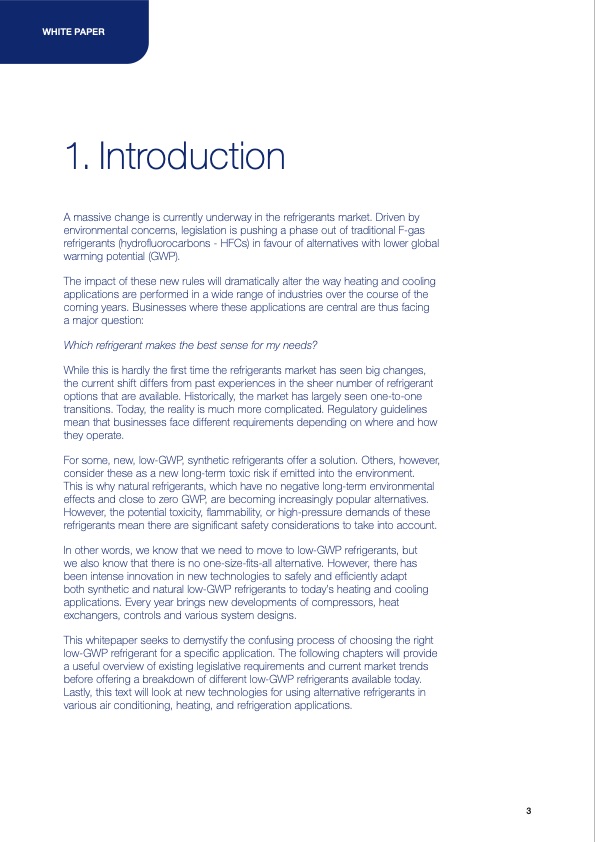
PDF Publication Title:
Text from PDF Page: 003
WHITE PAPER 1. Introduction A massive change is currently underway in the refrigerants market. Driven by environmental concerns, legislation is pushing a phase out of traditional F-gas refrigerants (hydrofluorocarbons - HFCs) in favour of alternatives with lower global warming potential (GWP). The impact of these new rules will dramatically alter the way heating and cooling applications are performed in a wide range of industries over the course of the coming years. Businesses where these applications are central are thus facing a major question: Which refrigerant makes the best sense for my needs? While this is hardly the first time the refrigerants market has seen big changes, the current shift differs from past experiences in the sheer number of refrigerant options that are available. Historically, the market has largely seen one-to-one transitions. Today, the reality is much more complicated. Regulatory guidelines mean that businesses face different requirements depending on where and how they operate. For some, new, low-GWP, synthetic refrigerants offer a solution. Others, however, consider these as a new long-term toxic risk if emitted into the environment. This is why natural refrigerants, which have no negative long-term environmental effects and close to zero GWP, are becoming increasingly popular alternatives. However, the potential toxicity, flammability, or high-pressure demands of these refrigerants mean there are significant safety considerations to take into account. In other words, we know that we need to move to low-GWP refrigerants, but we also know that there is no one-size-fits-all alternative. However, there has been intense innovation in new technologies to safely and efficiently adapt both synthetic and natural low-GWP refrigerants to today’s heating and cooling applications. Every year brings new developments of compressors, heat exchangers, controls and various system designs. This whitepaper seeks to demystify the confusing process of choosing the right low-GWP refrigerant for a specific application. The following chapters will provide a useful overview of existing legislative requirements and current market trends before offering a breakdown of different low-GWP refrigerants available today. Lastly, this text will look at new technologies for using alternative refrigerants in various air conditioning, heating, and refrigeration applications. 3PDF Image | guide for selecting and accommodating refrigerants

PDF Search Title:
guide for selecting and accommodating refrigerantsOriginal File Name Searched:
refrigerants-market_white_paper_en.pdfDIY PDF Search: Google It | Yahoo | Bing
CO2 Organic Rankine Cycle Experimenter Platform The supercritical CO2 phase change system is both a heat pump and organic rankine cycle which can be used for those purposes and as a supercritical extractor for advanced subcritical and supercritical extraction technology. Uses include producing nanoparticles, precious metal CO2 extraction, lithium battery recycling, and other applications... More Info
Heat Pumps CO2 ORC Heat Pump System Platform More Info
| CONTACT TEL: 608-238-6001 Email: greg@infinityturbine.com | RSS | AMP |